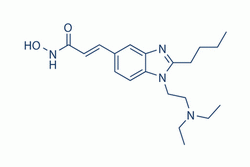| In Vivo: |
Pracinostat (SB939, 25-100 mg/kg) shows significant dose-dependent growth inhibition of HCT-116 xenografts. SB939 selectively accumulates in tumor tissue. SB939 (50 or 75 mg/kg) exhibits anti-tumor activities in the Apcmin genetic colon cancer mouse model[1]. Pracinostat (25 or 50 mg/kg per day for 21 days) induces significant inhibition of tumor growth (TGI), by 59 and 116%, respectively, in mice bearing MV4-11 xenografts. Pracinostat (75 mg/kg, q.o.d) in combination with pacritinib is efficacious and synergistic in vivo in two different models of human AML. Pracinostat and pacritinib have synergistic effects on AML-induced plasma cytokines/growth factors/chemokines[3]. |
| In Vitro: |
Pracinostat (SB939) is a potent novel hydroxamate-based inhibitor of HDACs class I, II, and IV, inhibiting the isolated enzymes with a Ki of 19 to 48 nM (class I), 16 to 247 nM (class II), and 43 nM (class IV), but with no activity against the class III isoenzyme SIRT I. SB939 has effects on HCT-116 colon cancer cell line and the HL-60 acute myeloid leukemia cell line, with IC50s of 0.48 μM and 70 nM, respectively. SB939 does not inhibit the proliferation of normal human dermal fibroblasts at concentrations up to 100 μM[1]. Pracinostat (SB939, compound 3) inhibits CYP2C19 with IC50 of 5.78 μM. SB939 shows potent activities against A2780, COLO 205, HCT-116, and PC-3 cell lines, with IC50s of 0.48 ± 0.21, 0.56 ± 0.08, 0.48 ± 0.27, and 0.34 ± 0.06[2]. Pracinostat downregulates JAK and FLT3 signaling in JAK2V617F and FLT-ITD cell lines, and shows synergy in combination with pacritinib. Pracinostat and pacritinib show in vitro synergy on STAT signaling and apoptosis. Pracinostat potently inhibits proliferation of different AML subtypes as a single agent and is synergistic with pacritinib in JAK2V617F or FLT3-ITD AML cell lines[3]. |






















